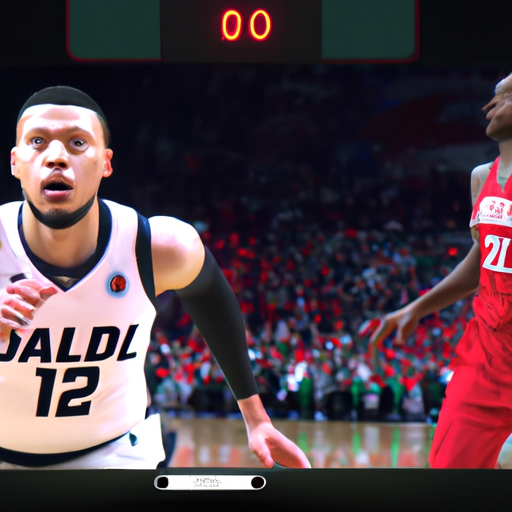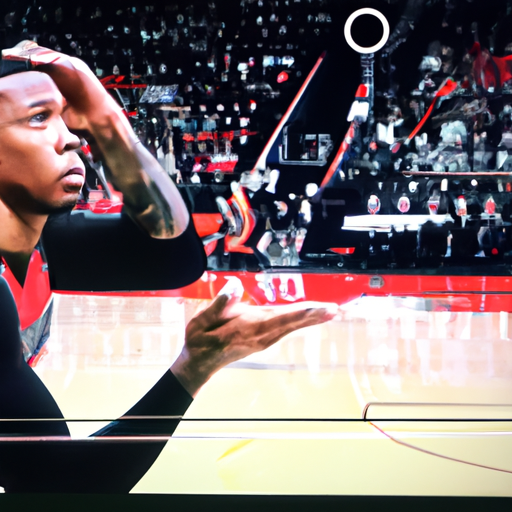Trail Blazers could delay Damian Lillard trade until February

The Impact of Damian Lillard’s Potential Trade on the Trail Blazers’ Season
The Portland Trail Blazers find themselves at a crossroads as they contemplate the potential trade of their star point guard, Damian Lillard. Rumors have been swirling around the NBA about Lillard’s desire to leave Portland and seek a championship elsewhere. This has left the Trail Blazers organization with a difficult decision to make, one that could have a significant impact on their upcoming season.
If the Trail Blazers decide to trade Lillard, it would undoubtedly be a major blow to their roster. Lillard has been the heart and soul of the team for years, consistently putting up impressive numbers and leading them to multiple playoff appearances. His departure would leave a void that would be difficult to fill, both on and off the court.
However, the Trail Blazers may choose to delay any potential trade until February for a couple of reasons. Firstly, by waiting until the trade deadline, the team would have a better understanding of their current roster’s capabilities. They would have a clearer picture of how well their new additions have integrated into the team and whether they have the potential to step up in Lillard’s absence.
Additionally, waiting until February would give the Trail Blazers more time to assess the trade market and explore all available options. They could gauge the interest of other teams and potentially negotiate a better deal for Lillard. This would ensure that they are not rushed into making a trade and can carefully consider all possibilities before making a final decision.
Another factor that could influence the Trail Blazers’ decision is the impact a potential trade would have on their season. If they were to trade Lillard before the start of the season, it would undoubtedly disrupt team chemistry and require a significant adjustment period. This could potentially hinder their performance on the court and jeopardize their chances of making a deep playoff run.
By delaying the trade until February, the Trail Blazers would give themselves a chance to see how well the team performs without Lillard. They could assess whether their current roster is capable of competing at a high level and potentially make a playoff push. This would also give them an opportunity to evaluate the development of their young players and determine if they have the potential to be future stars.
However, there are risks associated with delaying the trade. If Lillard’s desire to leave Portland becomes a distraction for the team, it could negatively impact their performance on the court. The constant speculation and media attention could create a toxic environment and hinder team morale. The Trail Blazers would need to carefully manage the situation and ensure that it does not become a major distraction for the players.
In conclusion, the potential trade of Damian Lillard has put the Portland Trail Blazers in a difficult position. They must weigh the impact of trading their star point guard against the potential benefits of waiting until February. By delaying the trade, the Trail Blazers would have a better understanding of their current roster’s capabilities and more time to explore all available options. However, they must also consider the risks associated with delaying the trade and the potential impact it could have on team chemistry. Ultimately, the decision will have a significant impact on the Trail Blazers’ season and their future as a franchise.
Exploring Potential Trade Scenarios for Damian Lillard and the Trail Blazers

The Portland Trail Blazers find themselves at a crossroads this offseason, with rumors swirling about the potential trade of their star point guard, Damian Lillard. While Lillard has been the face of the franchise for nearly a decade, the team’s recent playoff disappointments have led to speculation that a change may be necessary. However, it appears that the Trail Blazers may not be in a rush to make a move, as they could delay any potential trade until February.
One reason for this delay could be the desire to give new head coach Chauncey Billups a chance to work with Lillard and see if they can find success together. Billups, a former NBA champion and respected basketball mind, brings a fresh perspective to the team and may be able to unlock Lillard’s full potential. By waiting until February, the Trail Blazers would have a few months to evaluate the team’s progress under Billups and determine if a trade is truly necessary.
Another factor that could contribute to the delay is the upcoming NBA season. With training camps set to begin in September and the regular season starting in October, teams will have a better understanding of their roster’s strengths and weaknesses. This additional information could lead to more favorable trade offers for the Trail Blazers, as teams may be willing to part with valuable assets to address their own needs.
Additionally, waiting until February allows the Trail Blazers to assess the trade market more thoroughly. As the season progresses, teams will become more aware of their own playoff aspirations and whether they need to make a move to bolster their chances. This increased competition among potential trade partners could drive up the value of any potential deal for Lillard, giving the Trail Blazers more leverage in negotiations.
Furthermore, delaying a trade until February would also give Lillard an opportunity to showcase his skills and potentially increase his trade value. Lillard is widely regarded as one of the best point guards in the league, and a strong start to the season could remind teams of his immense talent. This could lead to more enticing trade offers for the Trail Blazers, as teams may be willing to part with even more assets to acquire a player of Lillard’s caliber.
Of course, there are risks associated with delaying a potential trade. Lillard’s value could decrease if he were to suffer an injury or experience a decline in performance. Additionally, the longer the Trail Blazers wait, the less time a potential trade partner would have to integrate Lillard into their system and maximize his impact. However, these risks may be worth taking if the Trail Blazers believe that a strong start to the season and increased competition among trade partners could lead to a more favorable deal.
In conclusion, while the Portland Trail Blazers have been the subject of trade rumors involving Damian Lillard, it appears that they may not be in a rush to make a move. By delaying any potential trade until February, the team can give new head coach Chauncey Billups a chance to work with Lillard and evaluate the team’s progress. Additionally, waiting allows the Trail Blazers to assess the trade market more thoroughly and potentially increase Lillard’s trade value. While there are risks associated with delaying a trade, the potential rewards may be worth it for the Trail Blazers as they explore potential trade scenarios for their star point guard.
Analyzing the Long-Term Consequences of Delaying Damian Lillard’s Trade until February
The Portland Trail Blazers find themselves at a crossroads as they contemplate the future of their star point guard, Damian Lillard. Rumors of a potential trade have been swirling around the league, with several teams expressing interest in acquiring the six-time All-Star. However, recent reports suggest that the Trail Blazers may choose to delay any potential trade until February, a decision that could have significant long-term consequences for the franchise.
One of the primary reasons for delaying a trade until February is the hope that Lillard’s value will increase over time. By waiting until the middle of the season, the Trail Blazers can showcase Lillard’s skills and leadership on the court, potentially driving up his trade value. This strategy is not without risks, as Lillard could suffer an injury or experience a decline in performance, but the potential rewards may outweigh the potential drawbacks.
Another factor to consider is the impact of delaying a trade on the team’s chemistry and morale. Lillard has been the face of the franchise for nearly a decade, and his departure would undoubtedly have a significant impact on the locker room. By delaying a trade, the Trail Blazers can give their players time to adjust to the idea of Lillard’s departure and potentially find a suitable replacement. This approach could help maintain team cohesion and prevent a sudden disruption in the middle of the season.
Furthermore, delaying a trade until February allows the Trail Blazers to assess the landscape of the league and evaluate potential trade partners more thoroughly. The NBA season is a dynamic environment, with teams constantly evolving and adjusting their strategies. By waiting until February, the Trail Blazers can gather more information about which teams are in need of a star point guard and which assets they may be willing to offer in return. This patient approach could result in a more favorable trade deal for the Trail Blazers.
However, there are also potential downsides to delaying a trade until February. One of the most significant risks is that other teams may lose interest or find alternative solutions to their point guard needs. The longer the Trail Blazers wait, the more time other teams have to explore different trade options or develop their young players. This could result in a smaller pool of potential trade partners and less leverage for the Trail Blazers in negotiations.
Additionally, delaying a trade until February means that the Trail Blazers will have to navigate the first few months of the season with a disgruntled star player. If Lillard is aware of the team’s intentions to trade him, it could create a toxic environment and negatively impact team performance. The Trail Blazers will need to carefully manage Lillard’s minutes and role on the team to ensure that his discontent does not become a distraction.
In conclusion, the decision to delay Damian Lillard’s trade until February is a calculated risk for the Portland Trail Blazers. While it offers the potential for increased trade value, improved team chemistry, and a more favorable trade deal, it also carries the risk of losing potential trade partners and creating a toxic environment. Ultimately, the Trail Blazers will need to carefully weigh these factors and make a decision that aligns with their long-term goals and vision for the franchise.

